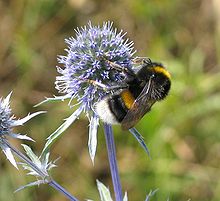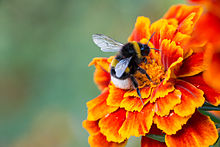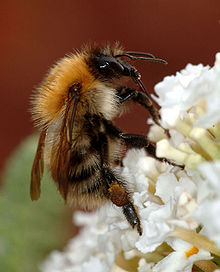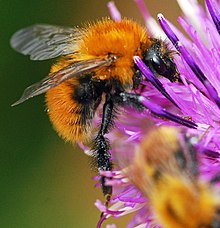Bumblebee
![]()
Bumblebee is a redirect to this article. For other meanings, see Bumblebee (disambiguation).
Bumblebees (Bombus) are a genus of state-forming insects belonging to the true bees. The Hymenoptera, the female of which has a spine, belong to the family of bumblebees, also known as wehrimmen. They are mainly found in the more temperate and cooler regions of the northern hemisphere.
Depending on the species, a bumblebee colony consists of about 50 to 600 animals and a queen. The majority of the animals are workers, but the colony also includes males, which are called drones as in honeybees, and young queens. In Europe, a colony survives only one summer and is usually dead by September. Only the mated young queens overwinter, and in the early spring of the following year they begin to build a nest on their own and thus establish a new state. Such queens reach an age of up to twelve months, of which they spend up to eight months in hibernation. Drones and workers, on the other hand, usually reach an age of only three to four weeks.
While honey bees only fly out at an outside temperature of at least 10 °C, bumble bee queens can be observed in early spring at temperatures as low as 2 °C and bumble bee workers at temperatures as low as 6 °C, since they generate the body temperature necessary for flying by vibrating their thoracic muscles.
Since the late 1980s, bumblebees have been used as pollinator insects in the commercial cultivation of fruit and vegetables. Their use in greenhouse cultivation of tomatoes is of great economic importance. Millions of bumblebee nests are artificially reared and shipped to vegetable growers worldwide each year. The most important species is the dark ground bumblebee.
Body type
The strong, roundish oval body consists of three sections: the head, thorax and abdomen. It is covered with fur-like hairs, which protects them from the cold, and also has multicoloured stripes. This colouring occurs in different ways, for example, in the field bumblebee and the stone bumblebee, while, for example, the dark ground bumblebee and the garden bumblebee have a white abdomen and are very similar. Bumblebees are often seen with bald, shiny areas on their bodies near the head. Hair loss occurs when the entrance hole to the nest is so narrow that when entering and exiting the nest, the affected areas are in contact with the edge of the hatching hole.
Bumblebees have a proboscis for feeding, which varies in length depending on the species. In queens the length is on average about 13 mm, in workers about 12 mm and in drones about 10 mm. There are paired antennae, compound eyes and transparent wings, as well as 6 multi-limbed legs.
Depending on the species, queens grow to between 15 and 23 mm in length, with a wingspan of 18 to 43 mm; workers and drones grow to 8-21 mm in length, with a wingspan of 18 to 34 mm. The size also varies within the respective species, both for drones and workers.

Dark earth bumblebee (Bombus terrestris) on flower head of a man litter species

Dark earth bumblebee collecting nectar

Close up of a bumblebee
Systematics
Within the bees, the bumblebees belong to the group of the cup-gatherers, a monophyletic group to which, among others, the honeybees also belong. The phylogenetic structure within the group has not yet been satisfactorily clarified; thus, according to the current state of research, it is not possible to say which is the sister group of the bumblebees.
The bumblebees themselves are divided into a number of about 35 subgenera, but their delimitation from each other is difficult, because the bumblebees have a very uniform body structure. Many authors have split off the cuckoo bumblebees of the subgenus Psithyrus as a genus of their own. Phylogenetic studies, however, indicate that differences in the physique of the cuckoo bumblebees are merely adaptations to the way of life, Psithyrus apparently does not form a sister group to the other bumblebees, as can be seen from the following cladogram:
| Bombus |
| ||||||||||||||||||||||||||||||
The attempt to split the genus Bombus into several monophyletic genera in order to be able to elevate Psithyrus to generic rank is generally considered unsatisfactory because of the uniformity of the entire group. Furthermore, since some parasitic bumblebee species are also known outside Psithyrus, Psithyrus is now considered by most authors to be only a subgenus.

Moss Bumblebee
Questions and Answers
Q: What is the genus of bumblebees?
A: Bumblebees belong to the genus Bombus.
Q: Where can bumblebees be found?
A: Bumblebees are mostly found in the Northern Hemisphere, but they can also be found in New Zealand and Tasmania. They occur practically everywhere on the Eurasian landmass.
Q: How long do bumblebee colonies usually last?
A: Bumblebee colonies typically last for one year, though the queen bee may live longer.
Q: What do bumblebees eat?
A: Bumblebees collect pollen as protein for their young, and they themselves eat nectar.
Q: What is a distinguishing feature of female worker bees?
A: Female worker bees have two "baskets" on their hind legs which are filled with pollen when collecting it from flowers. These baskets are just hairs specially adapted for this function and are very noticeable when full.
Q: What type of colouring do bumblebees have?
A: Most bumblebees have aposematic warning colours, usually some combination of black, red, yellow and white. This is known as Müllerian mimicry which is commonly seen in bees and wasps.
Q: How does hairiness help protect bumblebees from predators?
A: The extreme hairiness of bumblebees makes them difficult to handle for young birds who might otherwise prey on them, so this helps protect them from predators such as great grey shrikes (Lanius excubitor) or bee-eaters.
Search within the encyclopedia